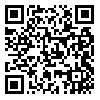Volume 5, Issue 1 (2-2024)
مطالعات فقه و حقوق رسانه 2024, 5(1): 61-93 |
Back to browse issues page
Download citation:
BibTeX | RIS | EndNote | Medlars | ProCite | Reference Manager | RefWorks
Send citation to:



BibTeX | RIS | EndNote | Medlars | ProCite | Reference Manager | RefWorks
Send citation to:
nasrollahi M S. The Historical-Legal Analysis of Cyberspace Filtering Regulation in IRAN. مطالعات فقه و حقوق رسانه 2024; 5 (1) :61-93
URL: http://journal.refah.ac.ir/article-1-72-en.html
URL: http://journal.refah.ac.ir/article-1-72-en.html
Abstract: (776 Views)
The protection of cyberspace and the Internet, in view of its penetration rate in the individual and social life of the society, is prioritizing the regulation of governments. this regulation is in the different levels of decision making from policies to the laws and regulations in the areas of media establishment, criminality and punishment, monitoring and control, etc. One of the control tools of the sovereigns, which is a matter of precautionary prevention, is cyberspace filtering. In our country, filtering, though it is one of the most sophisticated decisions of the sovereign, is at the same time the most challenging decision. Perhaps the filtering of the Telegram is a good example. The issue of this article is that the regulation of the filtering of cyberspace in Iran has undergone an evolutionary process, and in which ways does it have strong points and weaknesses?
The findings of this paper, using a descriptive-analytical method, show that cyber filtering has been accompanied by ups and downs as the fixed foot of the regulation of cyberspace has been. Among the important events of the filtering are the following: clarification of 7 legal documents for filtering, Internet starting with filtering to Iran, neglected such as the policy formulation of multi-level and home filtering since 2000, the design of a super-regulator in 2009, native approach in the filtering system in the year 2005. These phenomena and other phenomena have been attempted to be subject to legal analysis.
The findings of this paper, using a descriptive-analytical method, show that cyber filtering has been accompanied by ups and downs as the fixed foot of the regulation of cyberspace has been. Among the important events of the filtering are the following: clarification of 7 legal documents for filtering, Internet starting with filtering to Iran, neglected such as the policy formulation of multi-level and home filtering since 2000, the design of a super-regulator in 2009, native approach in the filtering system in the year 2005. These phenomena and other phenomena have been attempted to be subject to legal analysis.
Type of Study: Research |
Subject:
Special
Received: 2023/10/9 | Accepted: 2024/03/5 | Published: 2023/09/27
Received: 2023/10/9 | Accepted: 2024/03/5 | Published: 2023/09/27
Send email to the article author
| Rights and permissions | |
 |
This work is licensed under a Creative Commons Attribution-NonCommercial 4.0 International License. |




